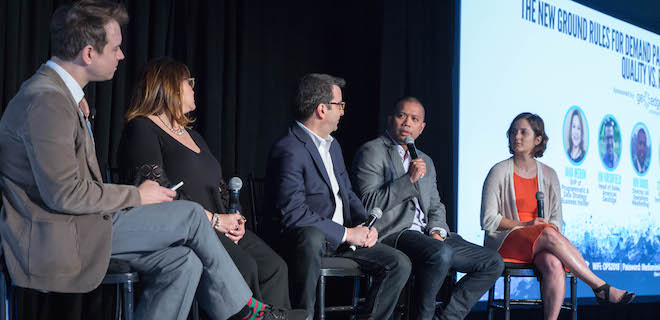
One of my personal favorite things about Ops is that foregone conclusions are almost guaranteed to be challenged. Even if you have some ideas on a subject, and even if you have research and stats to back it up, someone authoritative is probably going to disagree with you—and they might be right.
But again, you might both be right. Media and tech are complicated that way. Ops puts you in the same room as all these other people whose work is similar to yours, but different. You hear a lot of voices, and you can make decisions about who’s really speaking your language.
I was thinking about this while we were organizing this Ops panel discussion about demand partner evaluation. I had recently written a playbook on the subject, and the playbook was informed in part by a publisher survey we’d launched. One of the takeaways from that survey, and also from conversations I’d heard at AdMonsters Publisher Forums this year and last, was that publishers were getting more assertive, kicking aside (or at least pausing) demand partners who were too much trouble to work with, at too low a reward.
And in the first phone call we had with all the panelists (Jana Meron from Insider Inc., Jim Hischfield from the panel and playbook’s sponsor GeoEdge, Stephanie Layser from News Corp and Ron Duque from WeatherBug), that first takeaway was challenged straightaway. For premium publishers, was it even a new thing to hold demand partners to a very standard? Maybe, then, the marketplace has evolved so that more publishers can make the demands the super-premium pubs have been making all along.
But certainly other things have changed. Here’s some of what I heard from that panel at Ops itself. None of these takeaways alter what was in the playbook, but they certainly add to it:
- Sure, this current crop of redirects can seem more severe and more disruptive than certain malvertising attacks we’ve seen in the past. If it’s true that publishers today are quicker than they once were to put misbehaving demand partners on hold, the severity of these attacks may not be the primary instigator. Header bidding, and the transparency it opened up, has been a major driver in giving publishers a new understanding of their demand partners’ performance. By opening the header and allowing publishers to measure bid analytics, it’s easier to see which of your partners are adding quantifiable incremental value.
- In spite of the panel’s subtitle positive user experience and overall ad revenue are not necessarily opposed to each other (but we’ve been talking about this for a while). Good user experience can foster a more loyal audience. Poor user experience will drive the audience away. It’s pretty simple.
- Publishers need to push back on their demand partners when they’re served poor-quality ads—not only for their users’ sake, but to aid their broader business strategies. No publisher wants to develop a reputation among vendors and other publishers as “the one that doesn’t care about quality.” You have to keep your house in order, too: The ops team doesn’t want other teams within their company coming after them for messing with the ad stack. And no one wants to get an email about a bad ad over the weekend from a senior-management-level person in their company… not again, that is.
- When publishers have the ability to integrate a bunch of demand partners in the header, that means putting just one partner on pause may not affect their own bottom line very much. The downside is, it’s the same on the vendor’s side. The barrier to entry is lower for integrating with publishers. They can make up the lost business elsewhere if one publisher cuts them off.
- Cutting partners off entirely isn’t necessarily the way to go. If a publisher is unsatisfied with the response they’re getting from a partner, they can think of it as putting the partner in the penalty box. Give them time to respond in full and to fix the problem.
- There is a difference between a publisher and just a vendor. A partner keeps communication open, understands your goals, clearly responds to problems, and gives you access to the data you need to understand the value they’re delivering. Sometimes a partner’s value is less in the demand they deliver, and more in the tools they bring to the table.